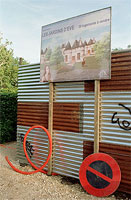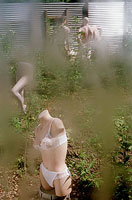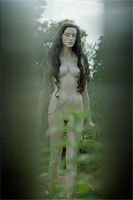|
Two years
ago I went to a garden design festival on the river Loire, in France.
40 or so gardens had been built, all selected for innovation of ideas,
material or execution. The festival is held in the grounds of a castle
overlooking the river Loire. The theme of the show that year was "Erotomania".
|
click to enlarge
|
 |
 |
 |
|
Figure 2
|
|
Céline
Orsingher et Laurent Bailly, Erotomania-Erotomachia, 2002
|
Nestling amongst
the fibreglass breasts, suspended underwear and other (small) feats
of the designers' imagination was a garden enclosed by a corrugated
iron wall. The only view of the garden was afforded by the occasional
peep hole. Within the walls was a scene of urban decay : weeds grew
high, plastic mannequins in various states of undress lay, erotically
I suppose, in the overgrown vegetation. Experiencing the garden via
the peephole made the experience short, private and intense. The title
of the garden was Erotomanie Erotomachie. (Fig.
1) Had the idea been Given by Duchamp? (Fig.
2) I asked its architects but received no reply.
|
click to enlarge
|
 |
 |
|
Figure 2
|
|
Marcel Duchamp, Given: 1.
The Waterfall; 2. The Illuminating Gas, 1946-66
|
There are other
links to be made between Duchamp and gardening…and Duchamp and
landscape, I'm here today to argue the case for Duchamp the gardener
and would love to hear the counter argument. I'll make them none the
less.
|
click to enlarge
|
 |
|
Figure 3
|
|
Marcel Duchamp, The Bride
Stripped Bare by Her Bachelors, Even, 1915-23
|
Let us take a famous
work: Fountain. I won't labour this point but the simple fact
is this man's fame rests on a water feature. Duchamps horticultural
aspirations can hardly be made more obvious…and the Large Glass…glass
and horticulture go hand in hand, in fact the Palm House at Kew gardens
is discussed by one contributor to Tout fait. Glass is a complicated,
conceptual, challenging material that both allows us grow tropical plants
in boreal places, as well as transmit cryptic artistic messages. Duchamp
chose the latter way of using it…but could have fairly chosen the
former.
What stronger argument
than these? If I must go on I will. Duchamp's liberation of Washington
Square (attempted) was not, I would argue, the drunken detail in Duchamp's
life has (regrettably) been bypassed by Duchampians. It shows a clear
commitment to the municipal landscape…possibly with aspirations
to community gardening. Duchamp was a great fan of New York City and
was it would not surprise me at all if he had been planning a post secession
community (organic) wildflower meadow for the children of New York.
Serious.
Not convinced?
I'll continue. Rrose Sélavy? Quoi plus dire? Duchamp was of the
field in name…of the flower in pseudonym. He didn't only think
about flowers but also about watering them, and selected this as a identifying
himself. A practical man as well as an aesthete…a landscaper. What
better qualification for my thesis?
Duchamp was once
described as being in an anti-nature phase, and defiantly turning his
back on a Forsythia bush (who wouldn't). He doesn't fool me. The line
between love and hate is a thin one.
I could go on,
there is a gardener in all of us. Duchamp was no exception. The big
question is why did he hide it from the world? It was nothing to be
ashamed of. Answers please.
Fig.
2-3
©2003 Succession Marcel Duchamp, ARS, N.Y./ADAGP, Paris.
All rights reserved.
|